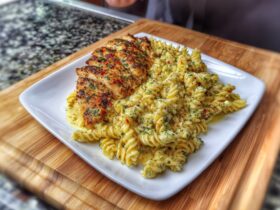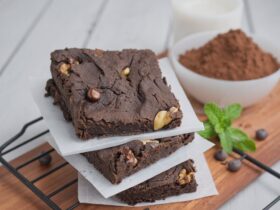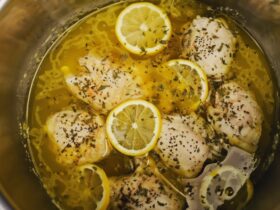Is there anything more comforting and impressive than a magnificent, perfectly cooked pork roast sitting at the center of the dinner table? For many, the idea of tackling a large cut of meat is daunting, filled with the fear of ending up with a dry, tough result. But what if I told you that creating a succulent, fall-apart tender, and deeply flavorful pork roast is far simpler than you think?
This classic pork roast recipe is your guide to culinary success. It relies on a simple yet powerful fresh herb rub and a low-and-slow roasting technique that lets your oven do all the work. We’re using a beautiful pork shoulder, a forgiving cut that, when cooked correctly, transforms into a juicy, melt-in-your-mouth masterpiece. Prepare to wow your family and friends with a Sunday dinner or holiday meal they won’t soon forget.
Ingredients
The magic of this recipe lies in its simplicity and the use of fresh, aromatic herbs. This combination creates a fragrant crust that seasons the pork shoulder beautifully as it roasts.
| Ingredient | Amount/Quantity |
| For the Herb Rub: | |
| Kosher Salt | 2 teaspoons |
| Freshly Ground Black Pepper | 2 teaspoons |
| Celery Seed | 1 ½ teaspoons |
| Fresh Sage, minced | 3 teaspoons |
| Fresh Rosemary, minced | 3 teaspoons |
| Fresh Garlic Cloves, minced | 2 tablespoons |
| Fresh Italian Flat-Leaf Parsley, chopped | 2 tablespoons |
| For the Roast: | |
| Pork Shoulder (Boston Butt) | 6-8 lb. |
| Chicken Broth | ¾ – 1 cup |
Timing
The key to this recipe is patience. While the total time is long, the vast majority of it is completely hands-off, letting the oven work its magic.
- Preparation Time: 15 minutes
- Tempering Time: 30 – 60 minutes
- Cooking Time: 3.5 – 4.5 hours
- Resting Time: 40 minutes
- Total Time: Approximately 5 to 6 hours
Step-by-Step Instructions
Follow these steps carefully, and you’ll be rewarded with a pork roast that is tender, juicy, and packed with flavor.
Step 1: Temper the Pork and Preheat Oven
Remove your pork shoulder from the refrigerator and place it on a tray on the counter. Allow it to sit for 30 to 60 minutes to come to room temperature. While the pork is tempering, preheat your oven to 325°F (165°C).
- Actionable Tip: Don’t skip tempering! Cooking meat straight from the fridge can lead to an unevenly cooked roast—overdone on the outside and underdone in the center. Letting it come to room temperature ensures it cooks evenly all the way through.
Step 2: Create the Fresh Herb Rub
In a small bowl, combine the salt, black pepper, celery seed, minced sage, minced rosemary, minced garlic, and chopped parsley. Mix all the ingredients together until they are well combined.
- Actionable Tip: Use the back of a spoon to gently press against the fresh herbs as you mix. This will slightly bruise them, releasing their essential oils and making your herb rub even more fragrant and flavorful.
Step 3: Season the Pork Shoulder

Pat the pork shoulder dry with paper towels. Liberally apply the herb rub all over the entire surface of the roast—top, bottom, and sides. Gently press the rub into the meat to help it adhere.
- Actionable Tip: A dry surface is key to forming a delicious crust. Make sure the pork is thoroughly dried before you apply the rub, ensuring it sticks to the meat and not your hands.
Step 4: Prepare the Roasting Pan

Place the seasoned pork roast in a large roasting pan with the fat-side facing up. Pour the chicken broth into the bottom of the pan until the liquid is about an inch deep.
- Actionable Tip: Placing the roast fat-side up is crucial. As the roast cooks, the fat cap will slowly melt and render, continuously basting the meat in its own juices. This is a built-in secret to a moist and tender result.
Step 5: Roast to Perfection

Place the roasting pan in the preheated oven. Roast the pork for approximately 35 minutes per pound. The roast is done when it reaches an internal temperature of 180°F (82°C). Use a meat thermometer to confirm the temperature.
- Actionable Tip: Periodically check the level of the chicken broth in the pan. If it evaporates, add a bit more to prevent the pan drippings from scorching. For ultimate accuracy, use a leave-in digital thermometer so you can monitor the temperature without ever opening the oven door.
Step 6: Rest the Roast
Once the pork has reached 180°F, carefully remove it from the oven. Transfer the roast to a large cutting board or a wire rack and let it rest for a full 40 minutes before carving or shredding.
- Actionable Tip: Do not cover the roast with foil while it rests. Tenting can trap steam, which will soften that beautiful, crispy crust you worked to develop. Resting it uncovered keeps the exterior crisp while the internal juices redistribute.

Nutritional Information
This is an estimate for a 6-ounce serving of roasted pork shoulder. Please note that values can vary.
- Calories: 450 kcal
- Protein: 40 g
- Carbohydrates: 1 g
- Fat: 30 g
- Saturated Fat: 11 g
- Sodium: 550 mg
Healthier Alternatives
This is a rich, comforting dish, but a few adjustments can be made if you’re looking for a lighter option.
- Trim the Fat: Before applying the rub, you can trim the fat cap, leaving about a 1/4-inch layer. You’ll still get the self-basting benefits with slightly less fat.
- Use Low-Sodium Broth: Opt for a low-sodium or unsalted chicken broth to better control the overall sodium content of the dish.
- Leaner Cut: For a much leaner alternative, you could use a pork loin roast. However, you must adjust the cooking method significantly—roast it to an internal temperature of only 145°F to keep it from drying out.
Serving Suggestions

A classic pork roast calls for classic sides. Here are some ideas to complete your meal:
- Pan Gravy: Don’t let those pan drippings go to waste! Use them to make a rich, flavorful gravy to pour over the sliced pork and mashed potatoes.
- Roasted Vegetables: Toss some quartered potatoes, carrots, and onions in the roasting pan with the pork during the last hour of cooking for an easy and delicious side dish.
- Classic Pairings: Serve alongside creamy mashed potatoes, garlic green beans, roasted Brussels sprouts, or a side of sweet applesauce to complement the savory pork.
Common Mistakes to Avoid
To guarantee a perfect pork roast, steer clear of these common errors.
- Cooking Cold Meat: As mentioned, cooking pork straight from the fridge leads to uneven results. Solution: Always allow the roast to temper on the counter for at least 30 minutes before it goes into the oven.
- Guessing the Doneness: Roasting times are an estimate. Ovens vary, and the shape of the roast matters. Solution: A reliable meat thermometer is the only way to know for sure when your pork is perfectly cooked.
- Slicing Too Soon: This is the biggest mistake! If you cut into the roast immediately, all the delicious juices will run out onto your cutting board. Solution: Let the roast rest for the full 40 minutes. This allows the muscle fibers to relax and reabsorb the juices, ensuring every slice is moist.
Storing Tips
Leftover pork roast is a fantastic ingredient for future meals!
- Refrigerate: Store leftovers in an airtight container in the refrigerator for up to 4 days.
- Freeze: For longer storage, you can shred or slice the pork and store it in freezer-safe bags for up to 3 months. A little bit of leftover pan juices in the bag will help keep it moist.
- Leftover Ideas: Use leftover pork to make incredible pulled pork sandwiches, tacos, pork hash with a fried egg on top, or add it to soups and stews.
Conclusion
Mastering this classic pork roast recipe is a kitchen skill that will serve you for years to come. It’s a testament to the fact that simple ingredients and proper technique can create an extraordinary meal. The aroma of fresh herbs and garlic filling your home is just the beginning—the real reward is the tender, juicy, and incredibly flavorful roast that results. This dish is more than just food; it’s about creating warm memories around the dinner table.
We’d love to hear how your roast turned out! Please leave a comment and a rating below to share your experience. And for more timeless recipes that are guaranteed to impress, don’t forget to subscribe to our blog!
FAQs
Q1. Why cook pork shoulder to 180°F? I thought pork was done at 145°F.
That’s a great question! While leaner cuts like pork loin and chops are best cooked to 145°F for tenderness, a pork shoulder is a tough, muscular cut with a lot of connective tissue. Cooking it to a higher internal temperature of 180-190°F is necessary to break down that collagen and fat, which transforms the meat into the tender, juicy, and easily shreddable texture we love.
Q2. Can I use dried herbs if I don’t have fresh ones?
Yes, you can substitute dried herbs in a pinch. The general rule of thumb is to use one-third the amount of dried herbs as you would fresh. For this recipe, you would use 1 teaspoon of each dried sage, rosemary, and parsley. However, the flavor of fresh herbs is highly recommended for the best result.
Q3. Can I cook this in a slow cooker?
A pork shoulder is fantastic in a slow cooker! You would apply the rub as directed and place it in the slow cooker with the broth. Cook on low for 8-10 hours, or until the pork is fall-apart tender. You won’t get the same crispy crust as you would in the oven, but it will be incredibly moist.
Q4. How do I make a simple gravy from the pan drippings?
It’s easy! After removing the roast to rest, skim off most of the fat from the drippings in the roasting pan. Place the pan over medium heat on your stovetop. Whisk 2 tablespoons of flour into the drippings to make a roux. Slowly whisk in about 1-2 cups of warm chicken broth or water until smooth. Let it simmer for a few minutes until it thickens, and season with salt and pepper to taste.
Print
The Perfect Pork Roast Recipe (Juicy & Tender Every Time!)
- Total Time: 5 hours 40 minutes
- Yield: 12–16 Servings 1x
- Diet: Gluten Free
Description
This classic pork roast recipe is your guide to culinary success. It relies on a simple yet powerful fresh herb rub and a low-and-slow roasting technique that lets your oven do all the work. We’re using a beautiful pork shoulder, a forgiving cut that, when cooked correctly, transforms into a juicy, melt-in-your-mouth masterpiece perfect for a Sunday dinner or holiday meal.
Ingredients
For the Herb Rub
- teaspoons Kosher Salt
- teaspoons Freshly Ground Black Pepper
- teaspoons Celery Seed
- teaspoons Fresh Sage, minced
- teaspoons Fresh Rosemary, minced
- tablespoons Fresh Garlic Cloves, minced
- tablespoons Fresh Italian Flat-Leaf Parsley, chopped
For the Roast
- lb. Pork Shoulder (Boston Butt)
- – cup Chicken Broth
Instructions
- Temper Pork & Preheat Oven: Remove the pork shoulder from the refrigerator and let it sit at room temperature for 30 to 60 minutes. Preheat your oven to ().
- Create the Herb Rub: In a small bowl, combine the salt, pepper, celery seed, sage, rosemary, garlic, and parsley. Mix well.
- Season the Pork: Pat the pork shoulder completely dry with paper towels. Apply the herb rub liberally all over the entire surface of the roast, pressing it into the meat.
- Prepare for Roasting: Place the seasoned pork in a large roasting pan with the fat-side facing up. Pour the chicken broth into the bottom of the pan.
- Roast to Perfection: Place the pan in the preheated oven. Roast for approximately 35 minutes per pound, until a meat thermometer inserted into the thickest part reads ().
- Rest the Roast: Carefully transfer the roast to a large cutting board. Let it rest, uncovered, for a full 40 minutes before carving or shredding. This step is mandatory for a juicy result.
Notes
- Don’t Skip Tempering: Letting the pork sit at room temperature for 30-60 minutes before roasting is crucial for it to cook evenly all the way through.
- Dry Surface = Great Crust: Patting the pork shoulder completely dry before applying the rub is the key to forming a delicious, flavorful crust.
- Fat-Side Up is Key: Placing the roast fat-side up allows the fat cap to melt and continuously baste the meat as it cooks, ensuring a moist and tender result.
- Rest Uncovered: Do not cover the roast with foil while it rests. Tenting can trap steam, which will soften that beautiful, crispy crust you worked to develop.
- Prep Time: 15 minutes
- Cook Time: 4 hours
- Category: Main Course, Dinner, Roast, Holiday
- Method: Roasting
- Cuisine: American
Nutrition
- Serving Size: 6 ounces
- Calories: 450kcal
- Sugar: 0.5g
- Sodium: 550mg
- Fat: 30g
- Saturated Fat: 11g
- Unsaturated Fat: 18g
- Trans Fat: 1g
- Carbohydrates: 1g
- Fiber: 0.5g
- Protein: 40g
- Cholesterol: 150mg



















Leave a Reply